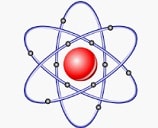The first step we are going to take in order to know the meaning of the term atomic orbital is to discover the etymological origin of the two words that give it shape:
-Orbital, on the one hand, derives from Latin. Specifically, it emanates from "orbit", which is used to refer to any trajectory that occurs in a circular manner. A word that, in turn, emanates from "orbis", which is synonymous with "roundness" or "circle".
-Atomic, on the other hand, has its origin in Greek. It can be translated as "relative to a very small matter that cannot be divided" and is the result of the sum of the following lexical components: the prefix "a-", which means "without"; the noun "tome", which is equivalent to "cut", and the suffix "-ico", which is used to indicate "relative to".
An atom is a particle that cannot be split through a chemical method. It is made up of a nucleus that is surrounded by electrons ( elementary particles whose electrical charge is negative).
 The electrons , then, rotate around the nucleus of the atom, making wave movements. The space where there is a high probability of finding an electron is called atomic orbital .
The electrons , then, rotate around the nucleus of the atom, making wave movements. The space where there is a high probability of finding an electron is called atomic orbital .
The atomic orbital, therefore, is a region found around the nucleus of an atom. In these areas, it is very likely that electrons will appear.
In short, depending on how the charge density of the electron surrounding the nucleus is distributed, the atomic orbital is determined. It can be said that each electron occupies an atomic orbital, defined by various quantum numbers .
An atomic orbital, on the other hand, can be referred to as a shell of the atom. The main layer is linked to a quantum number n , according to the so-called Schrödinger equation . This quantum number takes on integer values ( 1 , 2 ,…).
The closer the shell is to the nucleus, the lower its principal quantum number. In this way, the electron associated with the principal quantum number n = 1 is closer to the atomic nucleus than the principal quantum number n = 2 in that atomic orbital, for example .
It should be noted, on the other hand, that the electronic shells have a maximum capacity for accommodating electrons in the atomic orbitals. The main layers, in turn, can appear associated with sublayers .
Due to the characteristics of atomic orbitals, atoms are often considered as diffuse clouds , with the electrons orbiting the nucleus.
In addition to all the above, we cannot ignore that there are different types of orbitals if we take into account their shape. Specifically, among the most significant are the following:
-Orbitals "p", which are shaped like two flattened spheres towards what is their point of contact.
-Orbitals "f", which are made up of a total of four radial nodes.
-Orbitals "s", which are characterized because they have what is called spherical symmetry around the atomic nucleus.
-Orbitals "d", which can have different orientations.
